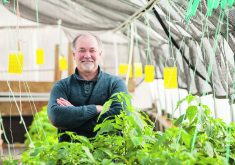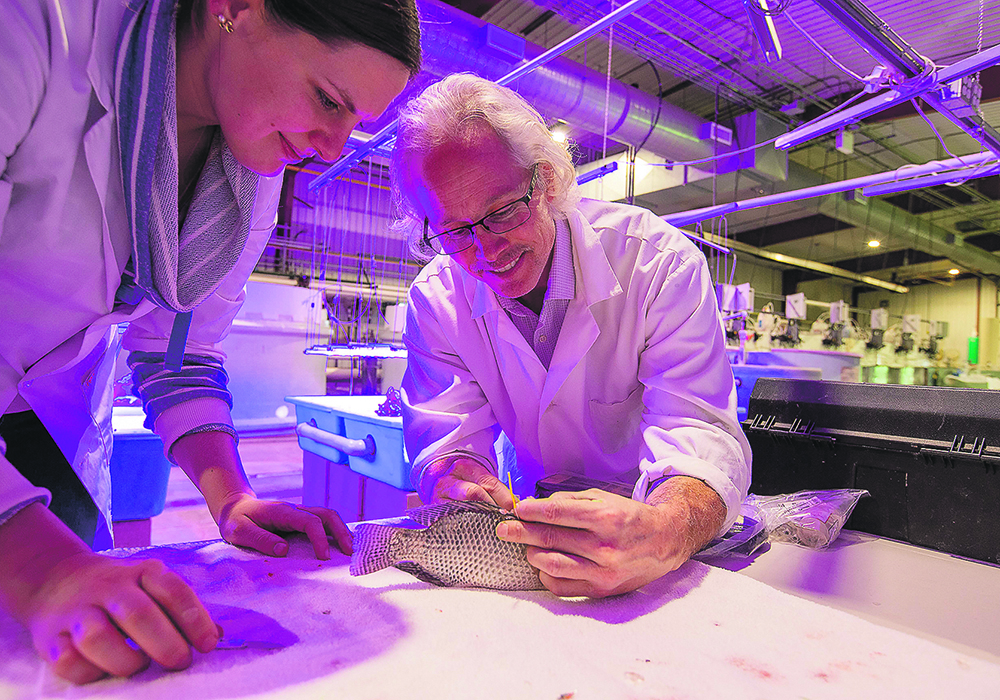Sure, you may have a great idea, but introducing a food product the world has never seen before makes for an extremely hard business case, according to David Melbourne.
“We blazed a trail for genetically engineered animal protein,” said Melbourne, Chief Commercial Officer of AquaBounty Technologies. “We are the first animal protein approved for human consumption in the (United States) and Canada.”
Melbourne was speaking remotely from New Hampshire at the ABIC Speaker Series event hosted by Ag-West Bio in Saskatoon last month.
In what must rank as one of the longest initial-innovation-to-consumer-plates periods ever, the company’s AquAdvantage salmon hit the market in 2021, 32 years after its initial development. About 25 years of this involved navigating the uncharted labyrinths of U.S. and Canadian regulatory authorities.
Read Also

Trump’s tariffs take their toll on U.S. producers
U.S. farmers say Trump’s tariffs have been devastating for growers in that country.
While this scenario might scare off all but the most iron-willed investors, Melbourne attributes much of the delay to being first. He also had some lessons learned to share. First, build working relationships, starting with the regulatory authorities.
“I highly recommend if you are exploring the path to regulatory approval is talk to the various federal government committees,” Melbourne said. “A big part of that is telling our own story. It’s not leaving it to detractors or others to tell the story for us.”
This means getting familiar with a lot of U.S. agency acronyms, including USDA, FDA, EPA and of course, Fish and Wildlife. Health Canada, Environment and Climate Change Canada, and the Canadian Food Inspection Agency are the equivalent players north of the border.
“These are all really important elements and folks we have to communicate with on an ongoing basis, Melbourne said. “Again, the regulations ultimately come from these agencies. It is critical that your company and your people are in front of these folks.”
He advised innovators to identify and prioritize stakeholders and develop a consistent, easily understood story of not just what the innovation is, but why it is important. For AquaBounty, this meant reaching out to organizations such as the World Wildlife Fund and the Nature Conservancy on the environmental side as well as chefs, dieticians and biotech associations. The company also seeks out online influencers and any channel that connects directly with consumers.
“It’s critical that your customers have your support to help tell your story,” Melbourne said. “You arm them with the messaging, you arm them with the components to speak to, but you’ve got to do that on their behalf as well.”
Choosing the right spokesperson is also critical – and it’s often not the person that developed the innovation. While his colleagues include “incredibly bright and really passionate” scientists, they can get “into the weeds with the science.” The challenge is to somehow translate that passion and brilliance.
“How do we tell the story in a manner that lay people will understand what it means?” Melbourne said.
Such tactics appear to be paying off. Melbourne said that “once they heard the AquaBounty story,” seven of 10 people polled intended to try the product.
After decades of fierce anti-genetic engineering activism, there are some signs that the regulatory hurdles are slowly coming down, at least for some techniques.
For example, a gene-edited cow with short hair that makes it more heat tolerant went from initial innovation to U.S. FDA approval in about two years. One crucial difference, however, was that Recombinetics, the company that produced the cow, introduced no outside genes. Another team of researchers used the same techniques to produce the polled trait in horned cattle. This promises to eliminate the need for dehorning, with benefits in terms of both animal welfare and livestock handling.
On the other hand, AquAdvantage salmon is a transgenic, meaning it contains genes from two other fish. The initial work was successfully done in 1989 at Memorial University in Newfoundland and Labrador. Researchers there were trying to solve the problem of salmon farmers losing stock due to cold water periods during the 36 months it took to grow to market weight. They came up with salmon that reached that weight in half the time, dodging the cold while also using less feed. A company, AF Protein (later AquaBounty) was launched to bring the innovation to market.
While the fish are the core technology, Melbourne explained that embracing Recirculating Aquaculture Systems (RAS) offers several advantages. It largely solved the public relations problem of possible escaped fish. It also allows tight control of water quality and temperature and, much like other high-intensity livestock operations, disease can be kept out of closed fish tanks. This means consistent quality product without a need for medications such as antibiotics.
Facilities can be built close to market, cutting down on the carbon cost of trans-ocean air transport from places such as Chile and Norway. Local production also puts fresh product in stores sooner, lengthening shelf life.
RAS fish farming tends to be efficient, with AquaBounty boasting a better than 1:1 feed-to-finished-product conversion ratio compared to about 6:1 for beef. Fish waste, like that of other livestock operations, is a good source of nitrogen, which can be spread on fields or used in combined aquaculture-hydroponics (aquaponics) operations.
Despite its age, AquaBounty is unusual: it is effectively a start-up, albeit one with 25 years of experience in RAS. Melbourne said they now have raised 14 to 15 generations of their GM salmon.
While the company’s Prince Edward Island facility has been around for decades and now produces all the brood stock and eggs for its production facilities, it was 2017 before the first AquAdvantage salmon, from a test facility in Panama, hit select consumers’ plates in Canada. It would be 2021 before its first production run of five tonnes came to market, and sold out, from its 1,200-tonne demonstration facility in Albany, Indiana.
Now, AquaBounty appears to be swimming successfully, going public to access capital through NASDAQ (AQB) and investing more than $290 million in a state-of-the-art 10,000-tonne facility in Pioneer, Ohio slated to come online in late 2023. The company plans to be producing 55,000 tonnes annually by 2028.















